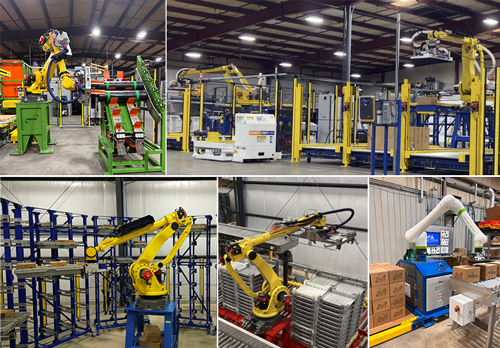
Leave Your Toughest Tasks to Robots
From the production floor to out-the-door, industrial robots do it better—getting your products where they need to be faster and more accurately, cutting down on human error, and eliminating the risks of repetitive motion injuries or workplace accidents.
Our wide range of applications for robotics unlocks 24/7 efficiency, ensures higher employee and customer satisfaction, and helps you seize long-term competitive advantages.
Our Systems and Solutions Run the Gamut of Industrial Robotics Applications
Robotic Material Handling
Enhance accuracy, precision, and workplace safety while improving efficiency and lowering labor costs. Material handling solutions free your workforce from repetitive tasks and protect them from hazardous environments while unlocking productivity.
- Board Handling
- Part Loading/Unloading
- Roll Handling
- Random Bin Picking
- Automated Vehicles
Omni-Channel Fulfillment
Warehouses, fulfillment centers, packaging plants, and outbound distribution centers come in all shapes and sizes. Our off-the-shelf and custom warehouse and fulfillment solutions accommodate all types to ensure superior fulfillment processes.
- Induction Depal or Each Pick
- Tote Handling
- ASRS
- Automated Vehicles
- ImpactIQ
End of Line Robotics
Improve the throughput, efficiency, and quality of the final stages of your production lines. Our end of line solutions get your products out the door faster, safer, and with minimum human errors for greater efficiency and customer satisfaction.
- Palletizing
- Packing
- Case Erecting
- Labeling
- Automated Vehicles
Why Choose Motion Controls Robotics for Automation Solutions?
FANUC Authorized Integration
MCRI is an authorized and certified system integrator for FANUC, the global leader in industrial robotics. From off-the-shelf to custom, our systems are highly dependable for any robotics applications.
Full Lifetime Product Support
To reap the full benefits of robotics applications, you need more than reliable hardware. You need a partner who is there for you whenever you need help—and that’s what you get with MCRI’s 24/7/365 support.
Comprehensive Operator Training
Our off-the-shelf FANUC robots and custom robotic cells are built for efficiency and ease of use. We make sure your workers receive operator training so you can make the most of any robotics applications.
Discover How the Right Applications of Robotics Transform Your Processes—for Free
Our free automation evaluation takes a thorough look into your facility and processes to show you exactly what you need to build a more efficient, safer, cost-effective, and innovative business. See for yourself how easy it is to automate your facility:
